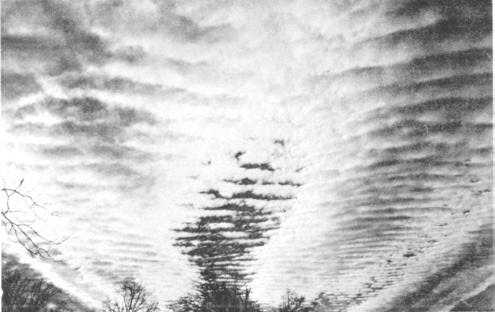mid-etage (fig. 1-20). Because of their greater height,
the elements of altocumulus clouds appear smaller than
stratocumulus cloud elements. The best way to judge
whether a cloud is altocumulus or stratocumulus is by
obtaining the height from the ceilometer or other cloud-
height sensors. Alternatively, an estimate of the size of
the individual elements is a reliable indicator.
Individual elements of stratocumulus clouds are wider
than 5°, while the individual elements of altocumulus
are narrower than 5°. The width of your three middle
fingers held at arm’s length is about 5°.
Precipitation rarely occurs with stratocumulus
clouds. When it does occur, it tends to be very light and
intermittent. Light snow showers (snow flurries) are the
most common form ofprecipitation from stratocumulus
clouds. Due to the light intensity of stratocumulus-
produced precipitation, more often than not any
precipitation will be in the form of virga.
The major species of stratocumulus clouds are
stratocumulus floccus, stratocumulus castellanus, and
stratocumulus stratiformis.
STRATOCUMULUS FLOCCUS.— Sirato-
cumulus floccus clouds appear as tightly-packed,
flattened cloud cells in a layer, with higher clouds or
blue sky visible in the area between the cells. Individual
cells have very indistinct, feathery edges.
STRATOCUMULUS CASTELLANUS.—In
the species stratocumulus castellanus, the individual
cloud cells develop in a stratiform layer. These cells
usually have rather indistinct edges and scattered
cumuliform buildups protruding upward from the
generally flatter tops of the stratiform cloud layer.
These buildups are commonly in the form of small
towers or tufts.
STRATOCUMULUS STRATIFORMIS.—
When a layer of cumulus humilis or cumulus mediocris
cloud cells begins to lose the clear definition on the
edges, such as is seen beginning at point C in figure 1-7,
the layer is classified stratocumulus stratiformis. As
development continues, these cells may merge,
completely tilling in the clear gaps between the cloud
cells.
Stratus (ST)
Occasionally, a layer of stratocumulus is mistaken
for a stratus cloud. The base of a stratus cloud has a very
smooth and uniform appearance, often appearing fuzzy
or indistinct. A stratus cloud base may have slightly
darker areas, but the darker patches are not arranged in
any regular pattern.
Stratus usually forms very close to earth's surface,
and is called fog when it is in contact with or within 50
feet of the surface. Stratus clouds may form in
conjunction with other higher clouds.
Figure 1-20.—Lower mid-etage altocumulus cloud.
1-18

